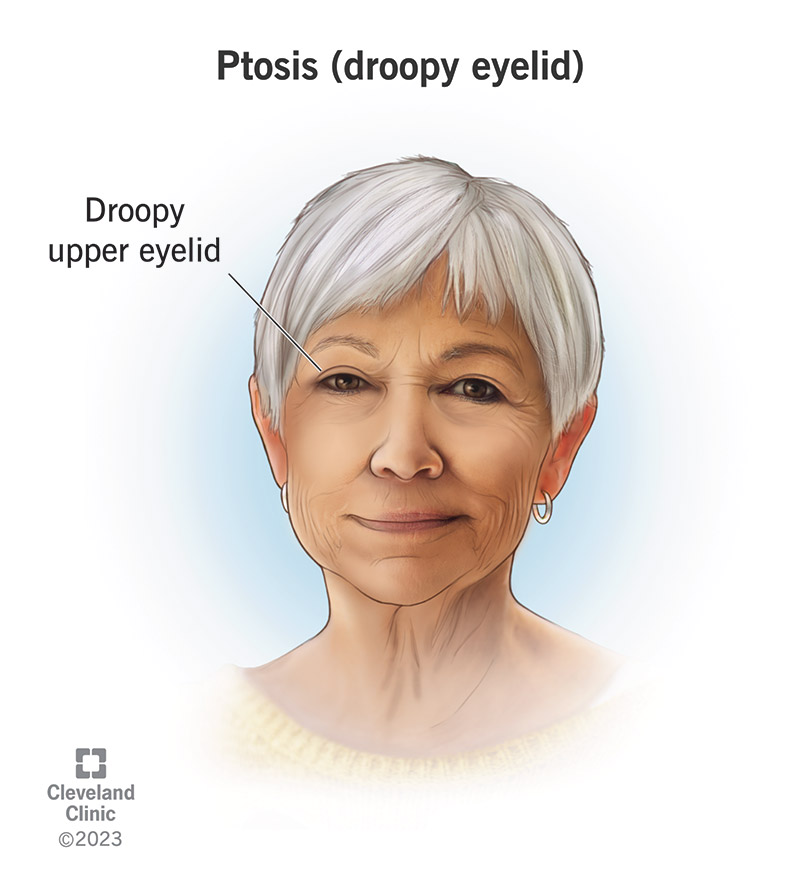Ptosis, or droopy eyelid, means your eyelids droop over your eye. This can impair your vision and lead to other complications. The condition can be present at birth (congenital) or acquired later in life, and there are treatment options available. If ptosis is affecting you, see your eye care specialist to discuss available options.
Advertisement
Cleveland Clinic is a non-profit academic medical center. Advertising on our site helps support our mission. We do not endorse non-Cleveland Clinic products or services. Policy

Ptosis is a condition in which your upper eyelid droops, sags or falls over your eye. It usually happens because your levator muscle — the muscle that lifts your eyelid — doesn’t work as it should. The condition can limit your vision or block it completely, depending on how much your lid droops. Ptosis of the eyelid can affect one or both upper eyelids. It can also be worse in one eye than the other.
Advertisement
Cleveland Clinic is a non-profit academic medical center. Advertising on our site helps support our mission. We do not endorse non-Cleveland Clinic products or services. Policy
Other names for the condition include blepharoptosis, upper eyelid ptosis or droopy eyelid.
Ptosis can affect both children and adults.
You can typically tell if you or your child has ptosis by your eyelid’s appearance. It may cover only your upper eye, or it may cover your entire pupil. Other ptosis symptoms may include:
Ptosis causes depend on the type. Some babies are born with ptosis in one or both eyelids (congenital ptosis).
Ptosis can occur later in life (acquired ptosis) if the muscles or ligaments that normally raise your eyelid are weakened by injury or disease. Sometimes, the drooping is a result of damage to the nerves that control your eyelid muscles.
Diseases and conditions that may result in ptosis include:
Advertisement
Most ptosis just happens with aging. As you age, the skin and muscles of your eyelids stretch and weaken. Sometimes, previous eye surgery speeds up this change because the instruments used to keep your eye open during surgery can stretch your eyelid.
If your child has congenital ptosis, the sooner you have it treated, the better. If left untreated, it could impact their vision development and lead to other issues. Mild acquired ptosis is less likely to cause vision problems, and you may not need to seek treatment. But severe ptosis can cause serious complications if you don’t treat it. Complications of ptosis may include:
Healthcare providers can typically detect ptosis by the appearance of a drooping eyelid. If both eyelids are affected, it may be more difficult to diagnose. Your healthcare provider will perform a physical exam. They may refer you to an eye care specialist (ophthalmologist) who will perform an eye exam and may request additional tests.
Tests that your eye care provider may perform include:
Ptosis treatment usually depends on how well your eyelid muscles are functioning. If the condition doesn’t affect your vision and the appearance doesn’t bother you, you might not need treatment at all.
If ptosis causes a problem with vision, appearance or both, your eye care specialist may recommend treatment. The type of treatment depends on whether the ptosis is caused by a disease or by aging. Treating ptosis caused by aging usually involves surgery.
Ptosis surgery is performed under local anesthesia with sedation (you’re awake but you don’t feel the procedure). The types of surgery to repair the droopy lid include the following:
Advertisement
After surgery, your surgeon will explain how to take care of your eye. It’s important to come back to your provider after surgery so they can check your results. Appointments are usually scheduled for several days to one week after surgery.
Complications can occur after ptosis surgery. Immediately following surgery, your eyelid height and shape may be asymmetrical. Your surgeon may have also under- or overcorrected your condition, which should resolve over time. Other complications of ptosis surgery include:
A prescription eye drop medication for adults with some forms of acquired ptosis is available. The medication is called oxymetazoline, and it targets the levator muscle. After using the drops, some people have noticed their eyelid opens wider. To continue working, you must use the drops every day. The drops don’t work for all forms of ptosis, so talk to your ophthalmologist to see if they’ll work for you.
The outlook (prognosis) for ptosis depends on the type and severity of the condition. If you need surgery, the outlook is generally good. Most surgeries to correct drooping eyelids are very successful.
Advertisement
You can’t prevent congenital ptosis since it’s present at birth (your baby is born with it). Most causes of acquired ptosis are difficult to prevent, as well.
You should see your eye care specialist if ptosis is affecting your vision. You should also reach out to them if:
If your child has ptosis, they should see an eye care specialist right away to assess their condition. Sometimes, their provider may recommend treatment immediately to prevent issues with vision development. Regardless if they receive treatment right away or later on, they should see an ophthalmologist regularly to keep track of their vision through regular eye exams.
If you or your child is having trouble seeing out of one or both eyes, check your eyelids. Are they drooping? Ptosis can be frustrating if you’re constantly tilting your chin up to see. You don’t have to live with the inconvenience. In fact, you shouldn’t. If left untreated, the condition can cause complications like astigmatism and amblyopia. Reach out to an eye care specialist to discuss your condition today.
Advertisement
Cleveland Clinic’s ophthalmologists and optometrists have the highest training available. We provide exams, vision correction and care for many eye conditions.

Last reviewed on 08/09/2023.
Learn more about the Health Library and our editorial process.